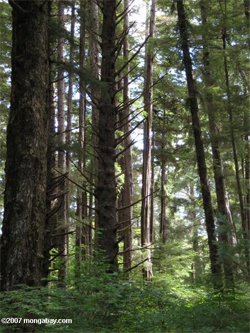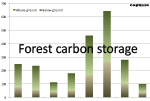|
|
Boreal forests in some of the world’s wealthiest countries are being rapidly destroyed by human activities — including mining, logging, and purposely-set fires — report researchers writing in Trends in Ecology and Evolution.
Assessing the status of the boreal forest that stretches across Alaska, Canada, Scandinavia, and Russia, Corey Bradshaw and colleagues found that less than 10 percent is protected, while about 60 percent is fragmented or degraded. The situation is the worst in Russia, which has “suffered the greatest decline in the last few decades compared to other boreal countries,” writes Bradshaw on his blog Conservation Bytes, adding that some 22 million hectares of Russian boreal forest burned in 2002 and 2003. Forests are also dying from outbreaks of pine mountain beetles, a consequence of warming temperatures. More than 13 million hectares of forest in western Canada have been affected in recent years.
 Forest near Ketchikan |
These changes are already having a significant ecological impact. 94 percent of the 348 of the boreal species appearing on the IUCN Red List are threatened with extinction, while fires and die-off are turning boreal forests — which contain 550 gigatons of carbon or 30 percent of Earth’s terrestrial carbon — into net carbon sources, worsening climate change, rather than helping mitigate it.
While damage from logging and disease is considerable, fire is the biggest threat to boreal forests. Without controlling fire, the authors conclude there will be little chance of saving these important ecosystems.
Bradshaw, CJA, IG Warkentin, NS Sodhi. 2009. Urgent preservation of boreal carbon stocks and biodiversity. Trends in Ecology and Evolution DOI: 10.1016/j.tree.2009.03.019
Related articles
Temperate forests store more carbon than tropical forests, finds study

(07/17/2009) Temperate forests trump rainforests when it comes to storing carbon, reports a new assessment of global forest carbon stocks published July 14th in Proceedings of the National Academy of Sciences (PNAS). The findings have important implications for efforts to mitigate climate change by protecting forests. Sampling and reviewing published data from nearly 100 forest sites around the world, Heather Keith, Brendan G. Mackey, and David B. Lindenmayer of Australian National University found that Australia’s temperate Eucalyptus forests are champions of carbon storage, sequestering up to 2,844 metric tons of carbon per hectare, a figure that far exceeds previous estimates. These forests, located in the Central Highlands of Victoria in southeastern Australia, are dominated by giant Mountain Ash (Eucalyptus regnans) trees, which can reach a height of 320 feet and live for more than 350 years. They are also favored by the timber industry. Mountain Ash forests have been widely logged across Australia, with only limited old-growth stands remaining.
Boreal forest fires important source of emissions
(10/31/2007) Forest fires in the boreal forests of Canada are an important source of greenhouse gas emissions reports a new study published in the journal Nature.
Boreal forests worth $250 billion per year worldwide
(09/25/2006) Boreal forests provide services worth $250 billion per year globally according to estimates by Canadian researchers. Mark Anielski, an Edmonton economist, says that environmental services from the boreal — including carbon capture and storage, water filtration and waste treatment, biodiversity maintenance, and pest control — are worth about $160 per hectare, or $93 billion per year in Canada alone.